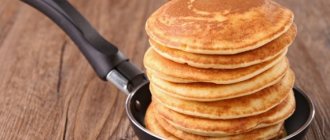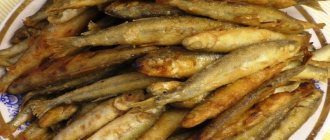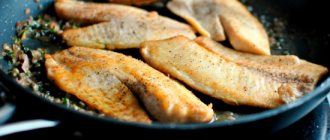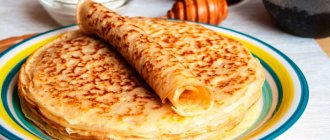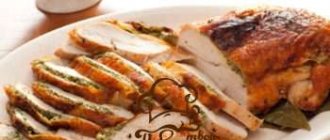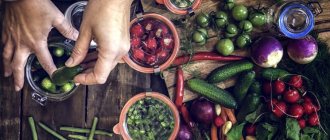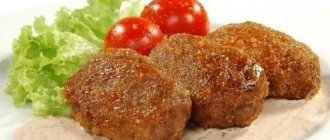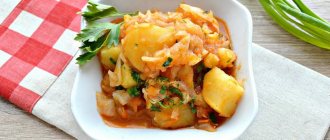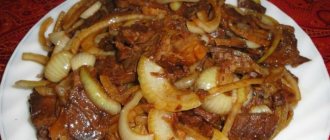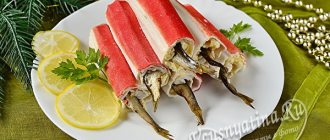Does your food keep sticking to the pan? That's just terrible! It is especially difficult to clean such dishes; it requires not only effort, but also time. Let me share life hacks with you. These helpful tips will help you not to curse the process of cooking, but to enjoy it. By following them, you can fry anything without sticking to the pan or burning. Will they tell me that it is best to have a non-stick pan? Well, what if you don’t have it or do you prefer traditional dishes?
Butter
They say that butter only promotes burning. In most cases this is a myth. You just need to use a natural product, not spreads. But many housewives try to save money this way. But, as they say, the miser pays twice. The ingredients in high quality natural butter are not only healthy, but their compounds will keep your pan from burning.
Don't put too much of it. For example, to cook scrambled eggs or an omelet for breakfast, a teaspoon is enough. If you're cooking with butter, don't heat the pan too hot.
A universal frying pan, but what is it?
No cook can do without a frying pan. Previously, this dishware was universal and served every housewife throughout her life. Although it was universal in preparing any dish, it did not stand out as particularly beautiful. A household item passes from generation to generation, continuing to serve its new owner. Today things are different. A huge selection of frying pans immediately raises a lot of questions. How to choose a frying pan in which you can fry chicken, vegetables and even pancakes? Or maybe it’s better to buy several frying pans at once and cook certain foods on them? To prevent choosing a frying pan from becoming a painful task, you should familiarize yourself with a number of important nuances.
What are we going to cook?
Every housewife should have several frying pans in her arsenal. It's convenient and practical. You're not going to take out a big cast iron skillet to fry a few eggs for breakfast. For such a case, a modern frying pan with a non-stick coating is perfect.
To prepare stews, you should purchase a large frying pan with high sides and a thick bottom. It should also have a lid and a comfortable handle.
If you love meat and always have steak, chicken breasts or chops on your menu, choose a grill pan. Thanks to the ribbed bottom, the dish will turn out not only tasty, but also attractive in appearance. It is also suitable for roasting vegetables.
A flat pancake pan with small sides is perfect for making pancakes for breakfast.
Chicken legs fried in a frying pan
Speaking about how chicken is cooked in a frying pan, one cannot fail to mention the “classic” chicken legs fried in a frying pan. This is pretty much the easiest fried chicken recipe out there. The meat is juicy and flavorful, and the crust is crispy. You can easily prepare this even if you have little cooking experience. This dish can become your signature dish; this is the best fried chicken recipe for those who want to impress loved ones with their brilliant culinary skills.
- chicken legs or thighs – 4 pcs;
- mayonnaise;
- garlic – 4 cloves;
- salt;
- seasoning for chicken (optional).
This recipe has two variations. The ingredients are the same, the only difference is how the garlic is introduced into the dish. It would seem like a trifle, but it is precisely such seemingly insignificant details that are called the “highlight” of the dish.
Option 1, classic.
- In this version, before cooking the chicken in a frying pan, you need to beat it a little. To do this, we cover the legs with cling film or put them in a food bag and beat them with a hammer. Next, prepare the sauce. Crush or grate the garlic, pour in mayonnaise, add pepper, salt and chicken seasoning. Mix. Rub the sauce over the chicken legs. Spread thickly so that the meat is thoroughly nourished. Place in the refrigerator for 1-2 hours.
- Pour oil into a frying pan, heat it up and add the chicken legs. Cover the frying pan with a lid of a smaller diameter and press firmly. This chicken recipe calls for pressure cooking the thighs, so a flat top that you can place a weight on will work best.
- After 15 minutes, remove the load, open the lid and turn the legs over. We repeat the procedure. After 10 minutes the dish is ready.
- Cut the garlic into small pieces, 1-2 mm wide. Take chicken legs or thighs. We slightly move the skin, but do not remove it completely. In the meat itself - under the skin, in the middle of the piece, we make narrow but rather deep cuts with the tip of a knife. Take cloves of garlic and insert them into the cuts.
- You can simplify this recipe even more - crush the garlic with a crush and simply push it under the skin without cutting into the meat.
- Mix mayonnaise with salt and pepper and also spread under the skin. Then we coat each leg and the top too. Let it marinate a little.
How does this version of the recipe differ from the previous one? Because the garlic remains under the skin, it will transfer its taste and aroma to the meat and will not burn. Mayonnaise will also be inside, which means the meat will be juicier and more tender. If you are wondering how to cook chicken in a frying pan so that it is soft and tender inside, with a crispy fried crust on the outside, then this recipe is for you.
Then everything is even simpler - the legs or thighs are laid out in a frying pan and fried in oil under a lid. Oppression is not necessary. As soon as one side is fried, turn it over to the other side. It’s easy to check whether the chicken is ready - you need to pierce the meat with a knitting needle or a narrow knife and check the juice that oozes out. If the juice is clear and colorless, the chicken is ready.
…and what to do with it?
The easiest and most logical way to prevent food from sticking to the pan is to place something between them that can separate them. There's a clever and simple trick I use when I want fried fish with crispy skin that won't have to be pulled off the bottom of the pan. Take a sheet of parchment, fold it in half, then again, then fold the paper in half 2-3 more times so that the fold line each time passes through the corner marking the center of the large sheet. Attach this corner to the center of the frying pan and cut the paper a little earlier than the walls of the frying pan begin, unfold it - and you will get a piece of parchment of a conditionally round shape with a diameter slightly smaller than the bottom of the frying pan, which is called the word “cartouche”. Place it in a frying pan, add oil and fry the fish, pressing it to the bottom with a spatula.
Everything ingenious is simple, isn't it? This technique can be used not only for frying fish, but also in other cases when you are afraid that your food will burn, but frying should not be too long.
But stop! In fact, we always put something between the food and the bottom of the pan that is quite capable of preventing it from sticking. This thing is called "butter".
Juicy fried chicken Tatar style
An unusual marinade for this recipe will make the meat taste incredible. Its secret ingredients are wine and adjika.
This point is familiar to everyone who has at least once tried to fry cutlets, pancakes, fish, chops or anything else in a frying pan without a non-stick coating. At first everything goes according to plan - you heat the pan, add oil, then start frying, and at the moment when it is time to turn the food over to the other side, you realize that it is stuck tightly. At best, you still manage to turn over your chicken breast, cutlet, or whatever you fried, significantly spoiling its presentation; at worst, you fall into panic while your failed dinner, stuck to the frying pan, quickly turns into coals...
Yes, as always, I exaggerated things a little, but anyone who has encountered such a situation knows that this is not funny at all. Well, in this case, you should be encouraged by the thought that there is a completely rational explanation for what happened, which means that next time it can be avoided. In this article, we will look at why food may stick to the pan, and what to do if this happens to you. So,
Now about metal
The type of metal used determines how quickly the pan will heat up and, of course, cool down. Will it allow you to quickly regulate the temperature while cooking, and so on.
The most popular materials are copper, cast iron, aluminum and stainless steel.
Copper
Copper frying pans are a favorite attribute in the kitchen of professional chefs. Their high price is justified by their beautiful appearance and ease of use. If they are used incorrectly, they will soon become deformed and the color will become dull. To extend the service life, manufacturers often begin to add stainless steel to copper.
Cast iron
If you choose a cast iron frying pan, be sure your children, then grandchildren and great-grandchildren will cook on it. They are practical, durable and very durable. Able to heat up quickly and maintain temperature for a long time. They are suitable for preparing meat and fish dishes, especially for stewing. You can also cook pilaf or cabbage rolls in them. The cast iron surface can be washed with a wire brush. When preparing a dish, you can safely use a fork instead of a wooden or silicone spatula.
Aluminum
This pan heats up and cools down equally quickly. It is very light, but at the same time deformable. Not suitable for use on a hob.
Stainless steel
It is very difficult to find a stainless steel frying pan without the addition of other metals. It stands out because it heats up very poorly. This is logical, since steel does not conduct heat well.
What kind of stove do you have?
The type of stove will determine which frying pan you buy:
- For gas burners, it does not matter what diameter the frying pan is or what material it is made of. The gas can heat any metal in a matter of minutes.
- As for electric stoves, their main requirement is that the diameter of the frying pan must match the diameter of the burner itself. It is preferable that the bottom is flat and smooth.
- If you have an induction hob, you will want to choose one that is magnetic (cast iron, steel, or made of stainless steel). Whatever material you prefer, the main thing is that the bottom is thick.
Oil is your friend and helper
What happens to food - that same cutlet or piece of chicken - after it is added to a frying pan with hot oil? High temperature instantly evaporates moisture from its surface, turning it into steam. But since the piece of chicken is lying in the frying pan, the steam cannot simply escape, and it lifts the product a little - it turns out to be something like an air cushion that forms a layer between the food and the metal, and prevents their interaction. The problem is that both the food itself and this steam are at a much lower temperature than the oil, cooling it, and if there was not enough oil (or you did not let it heat up properly), its temperature will drop below what is necessary for the water to evaporate, coming out of the product - and that’s all, good news.
What to do to prevent food from sticking to the pan
2806.20
Author: Irina
0
Such a problem as food sticking to a frying pan plagues many housewives. And even with extensive experience in cooking, not everyone can avoid this problem. In this article we will try to understand the reasons for this unpleasant phenomenon and talk about how to avoid it.
You've probably noticed that meat and fish products stick to the pan more often than vegetables. And this is no coincidence. To understand this, you need to understand a little chemistry. High protein foods react with the hot pan, causing the food to stick to it. And it’s easier to rid a frying pan of sticky vegetables than sticking meat or fish.
A lot also depends on the dishes. A frying pan with a non-stick coating is the best option, especially for beginners. But don’t think that you can put any product on it and it won’t burn even without oil. You will still have to add it, although not as much as in the case of other products. How hot the pan gets is not important for the non-stick coating.
But with cast iron frying pans you need to be more careful. To ensure that food has less chance of burning, the frying pan must be heated very well. The presence of oil is also required. Moreover, make sure that a little gets onto each area of the pan and covers it with an even layer.
But the most difficult case is a steel frying pan. Firstly, the difficulty is that it does not heat up equally in all areas, although heating occurs much faster than with a cast iron frying pan. The chance that food will burn on a steel frying pan is much higher. Therefore, you definitely need to warm it up well and pour more oil when frying.
To avoid food sticking to the pan, be sure to add oil. And the better it heats up, the thinner it will become and the better it will cover the surface of the pan. That is, it will even fill into all the microcracks.
From this follows the first rule - the presence of oil, and it is better if there is a lot of it. And the second rule is that the oil should be well heated, to a very high temperature, but not boil. It is worth considering that when the product gets into the frying pan, the temperature will drop sharply. And from this follows the third rule - the thicker the bottom of the frying pan, the less chance there is for food to stick.
These are not all the rules. There is also no need to save time by trying to cram more food into the pan. It is better to make smaller portions. Then the dish will turn out much more appetizing in appearance, and the nice crust will not remain stuck to the pan.
The next rule is to remove excess liquid from the product before frying. Paper towels are suitable for this purpose. Just dab what you want to fry in them.
As you already understood, foods high in protein almost always burn. This is especially true for fish. To avoid this, simply line the bottom of the pan with parchment paper. And oil is poured on top of it and the product intended for frying is placed.
But it happens that, despite following all the rules, you find that the food still sticks. Don't be too upset. There is a pretty good chance that after a golden brown crust appears, it will come off on its own. To make this happen faster, shake the pan slightly while frying.
Vegetables cook very quickly, so to prevent them from sticking, you need to stir them vigorously right away. More oil needs to be added. To prevent the cutlets from sticking, add water to them. Although they won’t get a golden brown crust, they won’t stick. If the omelette begins to stick, then first you need to try to peel it off from the edges, and then only move to the middle.
0
0
